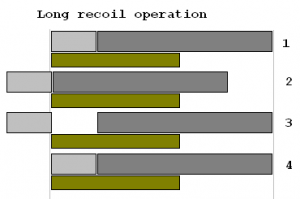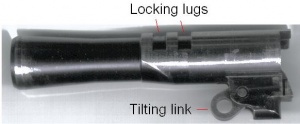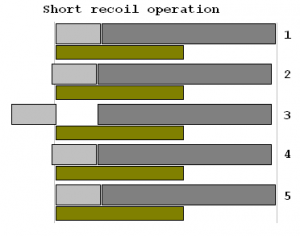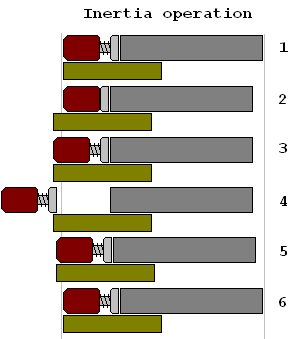Recoil operation
Recoil operation is an operating mechanism used in locked-breech, autoloading firearms. As the name implies, these actions use the force of recoil to provide energy to cycle the action. Other operating systems are blowback operated, gas operated, gatling, and chain.
Contents |
[edit] Design
- For every action, there is an equal and opposite reaction.
- ―Popular phrasing of Newton's third law of motion
When a projectile is accelerated down the barrel of a firearm, all or a portion of the firearm will begin to move in the opposite direction, as required for conservation of momentum, according to the formula:
- Bullet momentum = Recoiling momentum
which is calculated by:
- Bullet mass × bullet velocity = recoiling mass × recoil velocity
In non-recoil-operated firearms, it is generally the entire firearm that recoils. In recoil-operated firearms, however, only a portion of the firearm is allowed to recoil, while inertia holds another portion motionless relative to the recoiling mass. These two masses are coupled by a spring, that is compressed by the movement, and that serves to return the different masses to their original position.
Since there is a minimum momentum required to operate any given recoil-operated firearm's action, the cartridge must generate sufficient recoil to provide this momentum. Recoil operated firearms therefore tend to work best when using a cartridge with a grain size (mass) near where the gun's action was originally optimized or tuned in terms of momentum. For example, the M1911 design was optimized for a 230-grain (15 g) bullet, and, although there is a fairly-wide range over which different grain bullets may still operate reliably, the optimal operation will nonetheless occur around a 230-grain (15 g) bullet size, for standard factory springs.
[edit] Categories
Recoil operated designs are broadly categorized by how the parts move under recoil.
[edit] Long recoil operation
Long recoil operations are found primarily in shotguns, particularly ones based on John M. Browning's Auto-5 action. In a long recoil action, the barrel and bolt recoil all the way back as a unit. Once its rearward movement is absorbed by its recoil spring, the barrel is forced forward by the spring, where it unlocks from the bolt and returns to battery. The bolt, after compressing its own recoil spring, is held in the rearmost position until the barrel returns to battery. At this point, the fired shell has been extracted and ejected, and a new shell has been lifted from the magazine. The bolt is released by the return of the barrel, and is forced closed by its recoil spring. Long recoil operated firearms have a distinct "double recoil" feel to them, the "first recoil" being the halting of the rearward motion of the bolt and barrel, and the "second recoil" being the heavy barrel returning to battery.
Patented in 1900 by John M.Browning, the long recoil action is over a century old, and dominated the automatic shotgun market for more than half that century, before it was supplanted by new gas operated designs. While Browning halted production of the Auto-5 design in 1999, Franchi still makes a long recoil operated shotgun line, the AL-48, which shares both the original Browning action design, and the "humpbacked" appearance of the original Auto-5. Other weapons based on the long recoil system invented by John Browning were the Remington Model 8 semi-automatic rifle (1906), the Frommer Stop line of pistols (1907) and the Chauchat machine rifle (1915).
[edit] Cycle diagram explanation
- Ready to fire position. Bolt is locked to barrel, both are fully forward.
- Recoil of firing forces bolt and barrel fully to the rear, compressing the return springs for both.
- Bolt is held to rear, while barrel unlocks and returns to battery under spring force. Fired round is ejected.
- Bolt returns under spring force, loads new round. Barrel locks in place as it returns to battery.
[edit] Short recoil operation
The short recoil action dominates the world of centerfire automatic pistols, being found on nearly all of 9 x 19 mm or greater caliber. Short recoil operation differs from long recoil operation in that the barrel and bolt recoil only a short distance before they unlock and separate. The barrel stops quickly, and the bolt continues rearwards, compressing the recoil spring and performing the other actions of cycling. During the last portion of its forward travel, the bolt locks into the barrel and pushes the barrel back into battery.
The exact method of locking and unlocking the barrel is the primary differentiating factor in the wide array of short recoil designs. Perhaps the most unusual is the 1890 toggle bolt design of Hugo Borchardt, most famous for its use in the German Luger pistol. Most common are the John Browning tilting barrel designs, based either on the rotating link as used in the M1911 pistol, or the linkless cam design used in the Hi Power. The other common design is the Walther P38 locking block design, found in the modern Beretta 92 derived designs.
While the short recoil design is most common in pistols, the very first short recoil operated firearm was also the first machine gun, the Maxim gun. It used a toggle bolt similar to the one Borchardt later adapted to pistols. Browning also used the short recoil action in larger guns, including the M2 machine gun, or Ma Deuce, which has seen service for over 80 years as a heavy machine gun with all branches of the United States military. The German MG-34 and MG-42 dual-purpose machine-guns were also operated by short recoil.
[edit] Cycle diagram explanation
- Ready to fire position. Bolt is locked to barrel, both are fully forward.
- Upon firing, bolt and barrel recoil backwards a short distance while locked together, until the barrel is stopped.
- The bolt unlocks from the barrel and contines to move to the rear, ejecting the fired round and compressing the recoil spring.
- The bolt returns forward under spring force, loading a new round into the barrel.
- Bolt locks into barrel, and forces barrel to return to battery.
[edit] Muzzle booster
- main article: Muzzle booster
Some short-recoil operated firearms, such as the German MG-42 machine gun, use a mechanism at the muzzle to extract some energy from the escaping powder gases to push the barrel backwards, in addition to the recoil energy. This 'boost' provides higher rates of fire and/or more reliable operation. This type of mechanism is also found in some suppressors used on short recoil firearms, under the name gas assist or Nielsen device, where it is used to compensate for the extra mass the suppressor adds to the recoiling parts both by providing a boost and decoupling some of the suppressor's mass from the firearm's recoiling parts.
[edit] Inertia operation
The newest design in recoil operated firearms is the inertia operated system. In a reversal of the other designs, the inertia system uses nearly the entire firearm as the recoiling component, with only the bolt remaining stationary during firing. Because of this, the inertia system is only applied to heavily recoiling firearms, particularly shotguns. Currently the only inertia operated firearms are either made by Benelli, or use a design licensed from Benelli, such as Franchi.[1] In the Benelli implementation, a two part, rotating locking bolt, similar to that in many gas operated firearms, is used as basis of the action.
Before firing, the bolt body is separated from the locked bolt head by a stiff spring. As the shotgun recoils after firing, inertia causes the bolt body to remain stationary while the recoiling gun and locked bolt head move rearward. This movement compresses the spring between the bolt head and bolt body, storing the energy required to cycle the action. Since the spring can only be compressed a certain amount, this limits the amount of force the spring can absorb, and provides an inherent level of self-regulation to the action, allowing a wide range of shotshells to be used, from standard to magnum loads, as long as they provide the minimum recoil level to compress the spring. Note that the shotgun must be free to recoil for this to work--the compressibility of the shooter's body is sufficient to allow this movement, but firing the shotgun from a secure position in a rest or with the stock against the ground will not allow it to recoil sufficiently to operate the mechanism.
As the recoil spring returns to its uncompressed state, it pushes the bolt body backward with sufficient force to cycle the action. The bolt body unlocks and retracts the bolt head, extracts and ejects the cartridge, cocks the hammer, and compresses the return spring. Once the bolt reaches the end of its travel, the return spring provides the force to chamber the next round from the magazine, and lock the bolt closed.
[edit] Cycle diagram explanation
- Ready to fire position. Bolt is locked to barrel, both are fully forward.
- Upon firing, the firearm recoils backwards into the shooter's body. The inertial mass remains stationary, compressing a spring. The bolt remains locked to the barrel, which in turn is rigidly attached to the frame.
- The compressed spring forces the inertial mass rearwards until it transfers its momentum to the bolt.
- The bolt moves to the rear, ejecting the fired round and compressing the return spring.
- The bolt returns to battery under spring force, loading a new round and locking into place.
- The shooter recovers from the shot, moving the firearm forward into position for the next shot.
[edit] References
- Recoil operation, Animations and explanations of (short) recoil operation principle at howstuffworks.com
- Benelli's Innovations: Inertia Recoil Design
- M2 Machine Gun Operation




